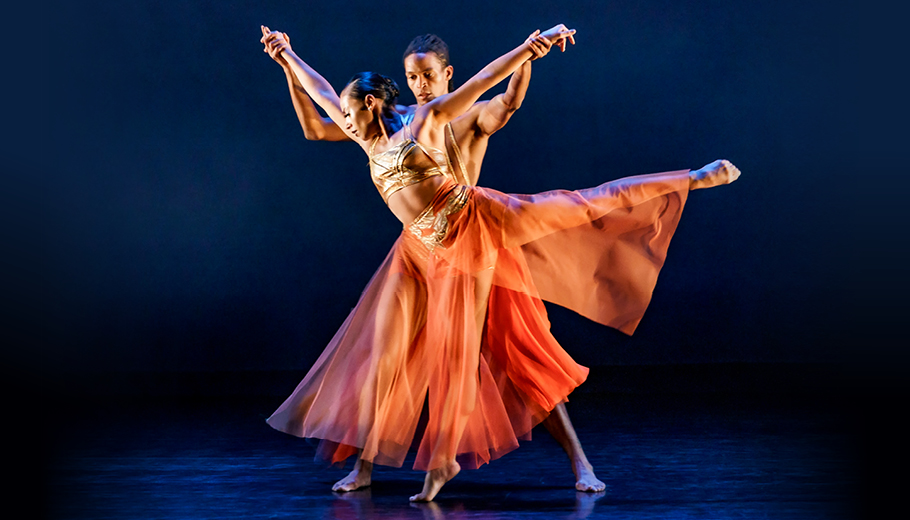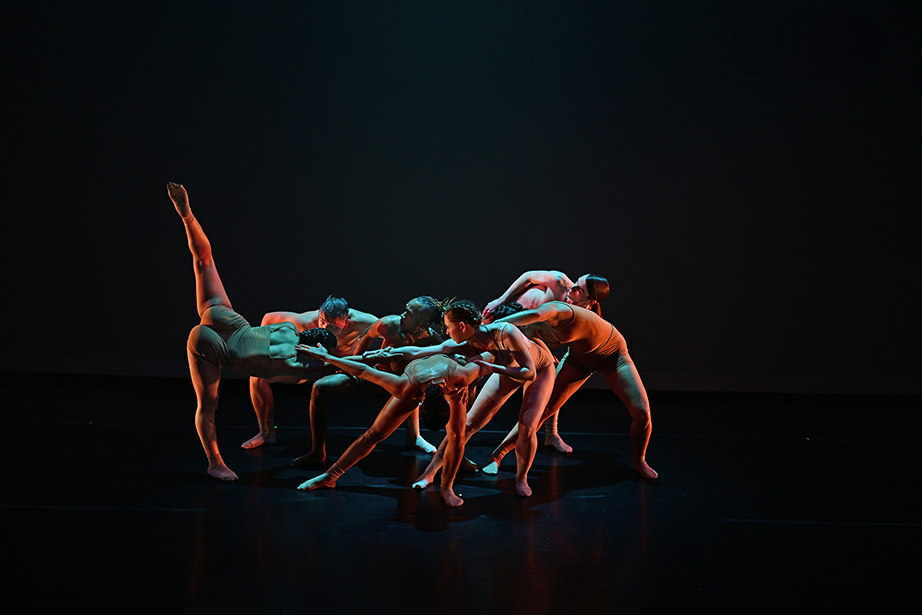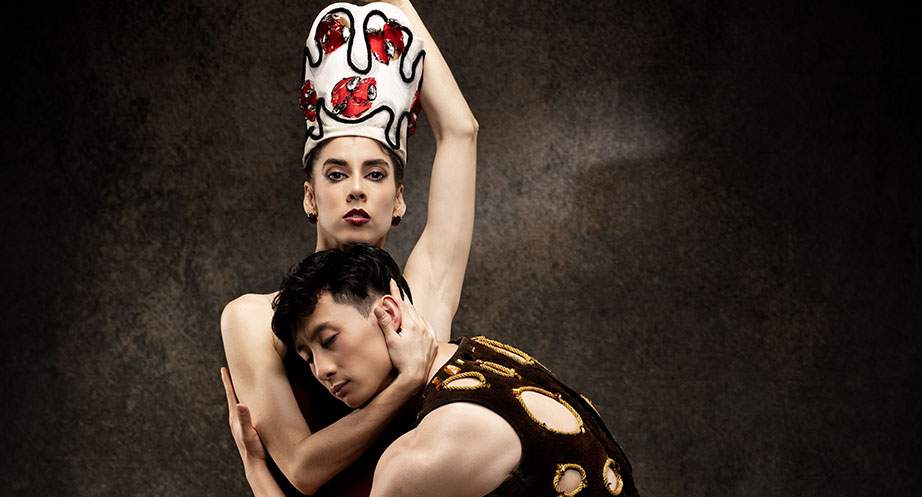
left to right – Julia Frey (Amy), Matteo Scammell (Kurt), Kevin Meehan (Jim), Allison Caw (Janis)
27 photos by Kevin Monko
by Lewis Whittington for The Dance Journal
One of the strongest tracks of The Live Arts Festival are its dance-theater genres, this year, two centerpiece shows- Lucidity Suitcase Intercontinental ‘Red-Eye To Havre de Grace’ and New Paradise Laboratories ‘27’– are prime exemplars of the of physical -theater and refined dance-theater elements.
‘27’ was conceived by NPL director Whit MacLaughlin, and is a completely choreographed musical play. The show turns the Plays & Players stage is turned into a desiccated show-biz ante-room to the Star hole, where the ‘27‘ club hangs out a twilight zone for famed rockers- Janis Joplin, Kurt Cobain, Jim Morrison and Amy Winehouse- who flamed out at aged 27. (Jimi Hendrix unseen, looms nonetheless through his guitar riffs)
When the players aren’t singing bits of their hits or mumbling non-sequiturs, they are hurling themselves around the stage in a cyclonic fury. “I feel like we were going back to our roots with this,” MacLaughlin said this week. “I didn’t want a tribute show in any way. For several weeks of rehearsal, I didn’t want to use the character names…Because it couldn’t be any sense an impersonation. We developed this program and I decided to use the famous names. It became less like actor characterization, more of dance characterization using the body as a canvass.” MacLaughlin explained.
He ended up using the names “because the characters became a distillation for…an ambient theater piece, a lamentation similar to that in music, it’s theater with all of the tropes of theater taken out.”
Kevin Meehan gives Morrison a snaky torso- oscillating gait that completely nails his aura. “Kevin’s Jim Morrison captures that ethereal arrogance and it is so choreographic, but not exactly dance,” MacLaughlin notes. Matteo Scammell‘s Kurt Cobain has a mournful serenity but breaks into acrobatic handstands and daring leaps, that imprints the singer’s intellectual nihilism. “He was…so conflicted about his power over people. He was suspicious of his capability. So intellectually, the essence of grunge,” MacLaughlin added.
Allison Caw‘s evokes Joplin’s epileptic arm movements which, in dance terms, are no less than superb port de bra framing Janis’ ballsy vulnerability, not to mention her livid flyaway hair. Julia Frey‘s gives Amy Winehouse a scorched soul look in her mile-high 60s bouffant and Cleo-eye make-up, meanwhile her physical expressiveness is spellbinding. She presses herself against the wall to sing desperately in ever more agitated retreat or she flees to the corner of the stage and incongruously takes on poses ala Nijinsky’s Faune. MacLaughlin noticed that Frey, as a new company member had a tendency to place herself on the periphery of the group, so he used her spatial sense to animate Winehouse.
MacLaughlin developed the solo physicality that played to an ensemble work “The choreography is group generated, but very much comes out of the individual characteristics of each actor, married some idea with the essence, or soul, of people they are playing.” In conjunction with the actors. I created a whole series of movement ideas that have nothing to do directly with the subject matter. Then a process of refinement, teaching each other choreography and then stylized the movement, in context.”
To a disturbing and ultimately concussive sound design, ‘27‘with what MacLaughlin calls “that ‘nodding ballet’ a minimalist evocation of heroin attacks. You can see them on the subway, they don’t want to lie down, and find the perfect balance point. They can’t be leaning, or dropping off-balance so much, but they are in their own cocoon, but they never show how imperiled they are. They don’t want to fall. I wanted to investigate what that state is.”
The movement recitative in ‘27‘ is the “loop” where the ensemble swirls violently around the stage. “There are musical loops and behavioral loops in this piece. I was thinking about what purgatory would be like, this movement is an extension of that.”
McLaughlin said he reached a high-bar physical level with the actors, then experimented even more. “One of the basis premises is to find the degree of difficulty that each performer can manage. Then extend it, the feeling that these particular bodies are embattled. I wanted them to express the body struggling and feel the strain of the choreography. As opposed to effortless movement. We talk about the illusion of the million time, where in theater we always go for the illusion of the first time. So as we moved along in rehearsals, I asked them to make it harder physically, because it creates a sort of animal energy,” the director said.
At the Suzanne Roberts Theatre, Thaddeus Phillips’ Red-Eye To Havre de Grace’ uses every inch of the Roberts stage to create the last days of Edgar Allen Poe while he is on tour performing The Raven along the northeastern corridor of Baltimore, Philadelphia and New York. Phillips describes the show as images “of Poe on trains in 1849 is wonderfully mysterious, and this musical follows Poe’s final journey, which had many crazy details, many rife with metaphor. “
As Poe, Ean Sheeny, reflects the author’s drug and alcohol use and Phillips has him in constant motion at times as animated as a silent film actor. He is reminiscent of silent film stars in many highly stylized moments of macabre physical comedy. But Sheeny is masterful in micro-acting moves as well, that build the harrowing psychological and surreal world of Poe. Sheeny gives a tour de force physical and vocal performance.
Phillips’ devises a constantly mutating set design with the set changes by the actors worked into the narrative to keep everything off kilter. The sense of unsettling travel and interior menace builds as Poe becomes more and more desperately escaping mental and emotional walls closing in. On Poe’s arrival at a Hotel in Philadelphia Poe is taken through the building’s corridors as they constructed and maneuvered in real time by the actors.
The play is laces together Poe’s biography and literature, dramatizing his poems ‘Beneath the Floorboards,‘ Tincture of Opium,‘ ‘Die Together,‘ ’Annabel Lee,’ among others. The poems are scored to original music by David Wilhelm and sung by bass baritone Jeremy Wilhelm. There are also disquieting musical interludes on the prepared pianos that underscore many of Phillips’ pure movement passages of Poe traveling in and out of reality.
The stylized movement in the play is by choreographer Sophie Bortolussi, who portrays Poe’s consumptive wife Virginia, who appears and vanishes, in several sleights of body all over the stage. She comes out of crawl spaces, walks blindly backward off tables, scales down sheets from a suspended sick bed. Bortolussi is the macabre and a floaty spectral, covering Poe when he is passed out on a bender, or a threatening presence, trying to pull him down an imagined void. The show’s most stunning sequence is Bortolussi’s stilt tango in the show’s denouement as grotesquely beautiful and disturbing as anything in Poe‘s imagination.
Red-Eye To Havre de Grace photos from Philadelphia Live Arts web site. No credit provided.
Mr. Whittington’s arts profiles, features, and stories have appeared in The Advocate, Dance International, Playbill, American Theatre, American Record Guide, The Harvard Gay and Lesbian Review Worldwide, EdgeMedia, and Philadelphia Dance Journal. Mr. Whittington has received two NEA awards for journalistic excellence.
In addition to interviews with choreographers, dancers, and artistic directors from every discipline, he has interviewed such music luminaries from Ned Rorem to Eartha Kitt. He has written extensively on gay culture and politics and is most proud of his interviews with such gay rights pioneers as Frank Kameny and Barbara Gittings.
Mr. Whittington has participated on the poetry series Voice in Philadelphia and has written two (unpublished) books of poetry. He is currently finishing Beloved Infidels, a play about the murder of filmmaker Theo van Gogh. His editorials on GLBTQ activism, marriage equality, gay culture and social issues have appeared in Philadelphia Inquirer, City Paper, and The Advocate.
- Philadanco’s Spring Dances - April 21, 2024
- A Day in the Life of Philly’s Master Choreographer, Dr. Rennie Harris - March 21, 2024
- Errand Into The Maze | The Life and Works of Martha Graham - March 1, 2024









